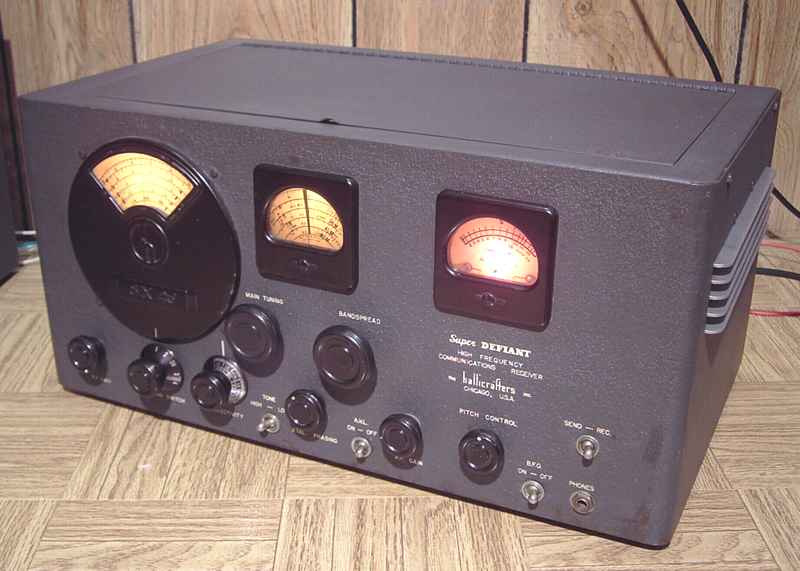
The "Super Defiant"
The SX-25 is was introduced in 1940. It is an upgrade to the lower cost SX-24 "Defiant" introduced the prior year. With 12 tubes compared to 9 in the SX-24, the SX-25 featured push-pull audio in place of the single-ended audio of the SX-24 and an additional tuned RF stage for all bands except AM broadcast.

Love that name.
Were the names "Defiant" and "Super Defiant" meant to portray the ability to fight off the noise and pull in that weak signal? Was it a response to the shortwave propaganda, militarism, and finally war that raged in Europe and Asia in 1939-40 but had not yet involved the USA? Was it named for a racing sail canoe that was a consistent winner in the thirties that bore the name "Defiant"? No reason for the name was ever made known. However, the name is quite imaginative.
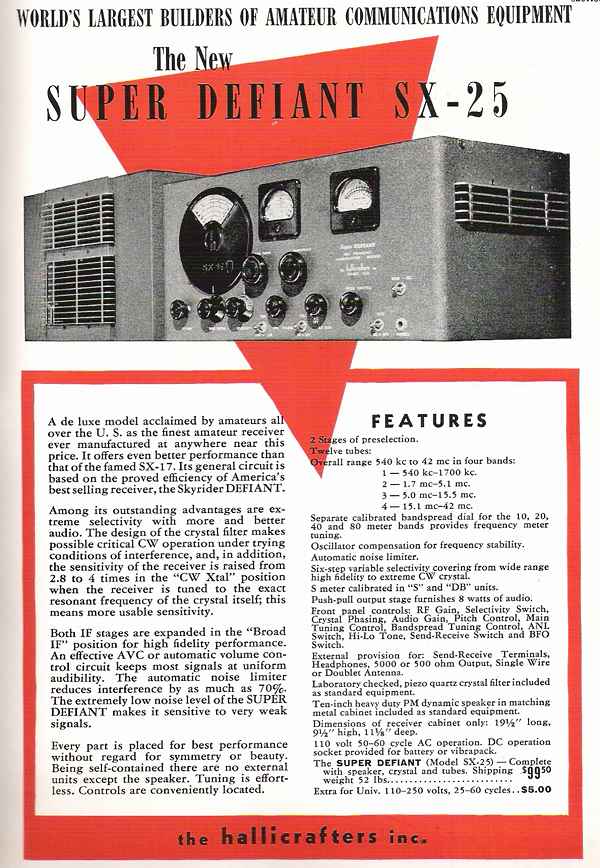
Like all other Hallicrafters with the "X" in the model name, the SX-25 is equipped with a crystal filter. Price of the SX-25 with speaker was $99.50 according to this 1940 ad.
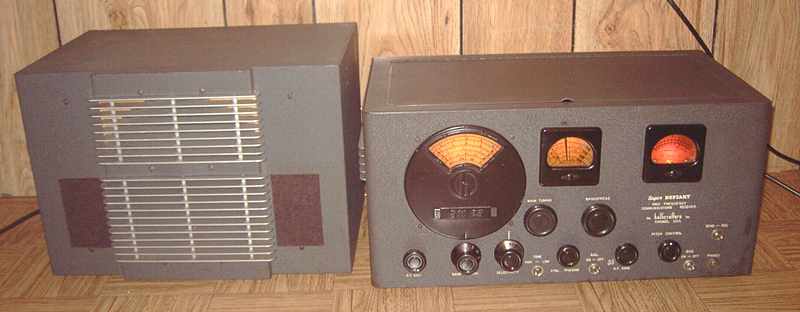
PM-23 Speaker
The SX-25 needs a matching transformer for its 500 or 5000 ohm impedance audio output. The PM-23 speaker was designed as a match for the SX-25 and well as the SX-28 and comes equipped with the proper transformer. The PM-23 shown with this SX-25 was completely gutted and used as a cabinet for a partly-built homebrew RF amp by a former owner. I replaced the 10 inch speaker and the interior plywood mount. The brown felt patches shown on the front cover several control holes drilled into the cabinet. The grille was painted with the proper silver automobile touch-up color, but the cabinet paint is original. For now, I am leaving it that way. My other PM-23 is original and is complete with the chrome "h" logo on the grille. It accompanies my SX-28.
The SX-25 made a cameo appearance in the U. S. Army film "Resisting Enemy Interrogation" made during the war to train airmen in what to say and not to say should they be captured as a Prisoner Of War. The Hollywood actors costumed in German uniforms are shown listening to POW airmen from a hidden microphone via the SX-25 prop. The "Super Defiant" labels are covered up for the prop.
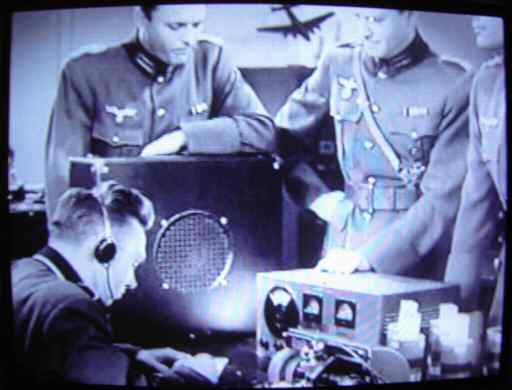
Cosmetics
I bought this SX-25 because the cabinet was in very decent cosmetic condition along with the silk screen labels. I cleaned it and the chassis with white waterless hand cleaner. The ventilation louvers were repainted with silver-color automobile touch-up paint.
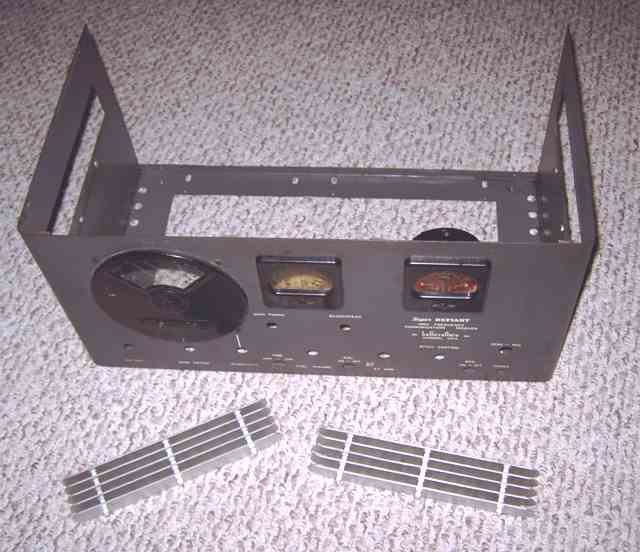
Repairs
After safety checks, I powered the set slowly. The electrolytics reformed readily.
The sensitivity of the set was marginal and the audio relatively low even with the the volume and RF gain controls cranked fully. The problem was primarily in the audio stages. I tested the tubes especially the 6SQ7 pair and the 6F6 pair. The problem turned out not to be the tubes but the poor connections between the tubes and the tube sockets. I used a brass-bristle brush to remove oxidation from the tube pins and also used deoxit contact cleaner on the pins and sockets. Deoxit was also applied to the bandswitch contacts, the control pots, and the switches.
All of the audio coupling capacitors and a number of other caps were replaced. Voltages were checked. At each point, improvement could be noted. The radio finally was exhibiting the sensitivity and volume level I had expected. On a local station, there was sufficient volume even with the volume control barely beyond the grounded end. I replaced the power cord with a 3-wire grounded version and added an in-line fuse.
While the radio performed quite well on the wider bandwidth settings, the crystal filter did not work. A quick check with a frequency counter showed why. The radio had been aligned to an IF frequency of about 470 KHz. The crystal was supposed to be at 455 KHz or close. Thinking that possibly the crystal itself was bad or off frequency, I pulled the crystal and placed it in series with my signal generator output and my oscilloscope input. It passed a very pronounced signal at 454.75 KHz, nearly on the nose for its design. This was excellent since I had previously tested a crystal from another SX-25 at 453 KHz, still within an acceptable margin but not as close as this one.
The next step was a total realignment of this SX-25.
Since the crystal was working well, the next step was to pull out the Rider and Hallicrafters instructions on alignment. The 455 KHz alignment is conventional with the exception of the secondary of the first IF, identified as "T1S" in the instructions. The instructions in Rider volume 11 do not identify the first IF. It is the IF closest to the front panel. The "T1S" is the adjustment screw closest to the back of the cabinet. I rocked the signal generator a bit to find the crystal's sweet spot and (about 454.75 as noted above) and aligned on that.
The BFO needs help
To properly follow the alignment procedure, the BFO needs to be working. After adjusting the IF chain to the proper setting, the BFO would not work. Since it had worked previously, I assumed I could adjust it to zero beat at the proper IF setting. I was wrong. The BFO would not go down to 455 KHz. I checked with my little hand held frequency counter but found that the lowest setting was about 462 or so. Apparently a previous owner had changed the mica capacitor that resonates with the BFO coil, probably to bring it up to the frequency of the wrong IF alignment. I removed the cap and substituted a new dipped mica and finally adjusted the BFO coil to 455 KHz.
With the IF chain at the proper frequency, the local oscillator and all of the RF trimmers for the 4 bands needed realignment. The receiver had apparently also been aligned with the bandspread cap fully meshed, another error. I suspect that the bandspread cap error caused a need to adjust the IF chain to the higher setting.
Listening after repairs and alignment
Once the set was properly aligned, I had a fun experience band cruising on AM broadcast, the international shortwave bands, and the lower ham bands. The performance was excellent, about what one would expect for a single conversion receiver with two tuned RF amp stages and two IF stages. Tuning SSB was relatively easy even without a product detector. It made me wish I had had one of these as my first shortwave and ham receiver. The 8 watts of audio with the 10 inch PM-23 speaker was also enjoyable.
A Radio Manufacturing Engineers (RME) DB-20 preselector was the previous item on the bench.